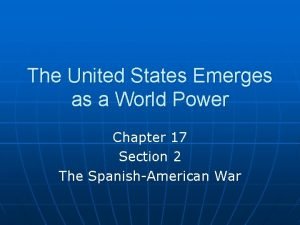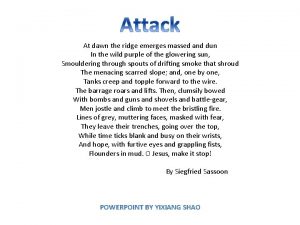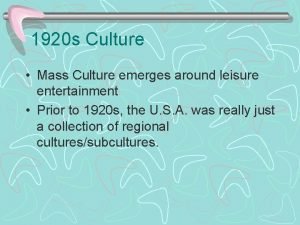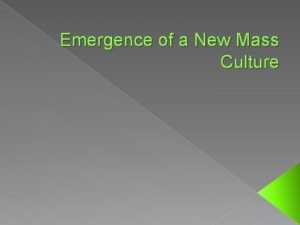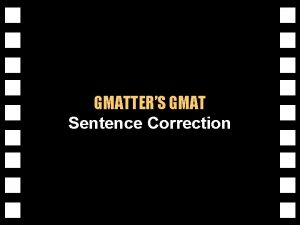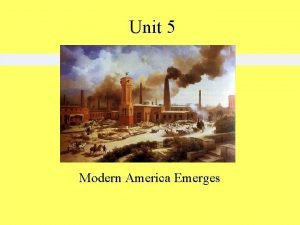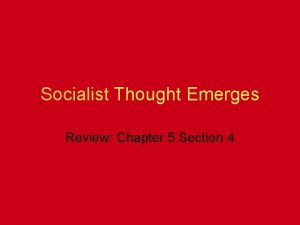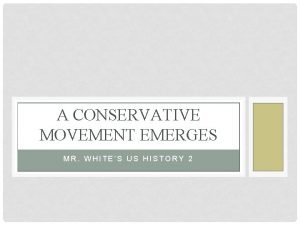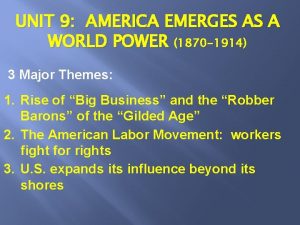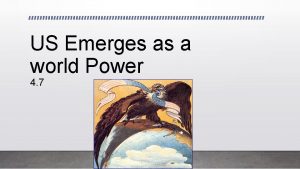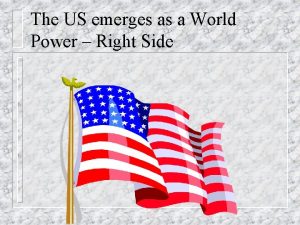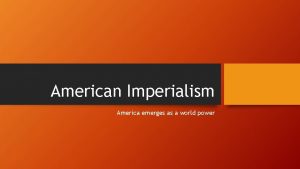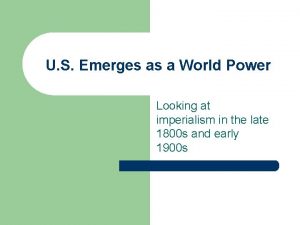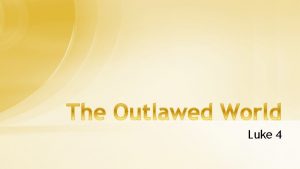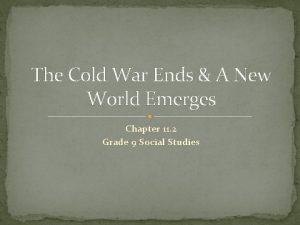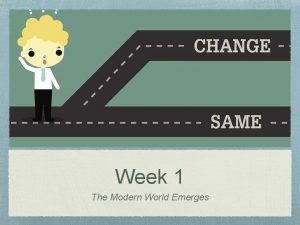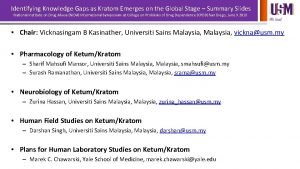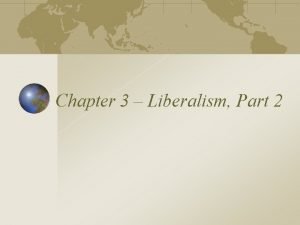US Emerges as a world Power 4 7














- Slides: 14

US Emerges as a world Power 4. 7

America Comes of Age (1890 -1920) Lesson 7 The United States Emerges as a World Power Learning Objectives • Key Analyze how economic concerns influenced the Open Door Policy and U. S. relations with Japan. • Examine what happened to Puerto Rico and Cuba after the Spanish-American War. • Analyze the effects of Roosevelt’s “big stick” diplomacy and Taft’s “dollar diplomacy. ” • Compare Wilson’s “moral diplomacy” with the foreign policies of his Terms predecessors. • Foraker Act • spheres of influence • Platt Amendment • John Hay • “big stick” diplomacy • Boxer Rebellion • Panama Canal • Open Door Policy • Roosevelt Corollary • Russo-Japanese War • “dollar diplomacy. ” • “Gentlemen’s Agreement” • “moral diplomacy” • Great White Fleet • Francisco “Pancho” Villa

Policy in Latin America • Treaty of Paris – ended Spanish American War • Gave US control over Cuba + Puerto Rico • Puerto Rico • Foraker Act – establishes civil government in Puerto Rico • Puerto Ricans still do no enjoy same rights as US Citizens • Cuba • Teller Amendment – prevents USA from annexing Cuba • Passed during the Spanish American War • Platt Amendment – addition to the Cuban Constitution • Restricts the rights of Cubans • Makes Cuba a US “protectorate” • Guantanamo Bay – US Military Base

US Relations with China • Spheres of Influence – • Sphere or area that a country has privileged access to ports and markets • Britain, France, Germany and Russia carve up China • Japan – China + Korea. • America left out… limited America’s trade/foreign investment • US Sec. of State John Hay – demanded equal access to trade w/China • Boxer Rebellion – • Chinese join rebellious groups against “foreign devils” – “Boxers” • Martial Arts, celebrated Chinese traditions, criticized western ideals, condemned Christians • May 1900 – “Boxers” kill foreign missionaries • Multinational force of 20, 000 puts down the Boxer Rebellion • Chinese nationalists force the emperor out in 1911 • Open Door Policy – equal privilege and free trade with China • No colonies – only free trade • US economy boosts because of trade with China

U. S. Trade and Intervention in China Analyze Maps What can you conclude about the influence of the United States in China during the early twentieth century?


Modern Trade with China

US – Japan Relations • Japan looks to expand Imperialize Korea + China • Russo-Japanese War • Japan upset that Russia seized control of Manchuria • Feb. 1904: Japan attacks Russia’s naval fleet in China and invades Manchuria • 1905: T. Roosevelt negotiates peace • - TR wins Nobel Peace Prize to end Russo-Japanese War • Anti-Asian sentiment grows in USA • 1906: San Francisco bans Asian students from attending schools with Whites (Jim Crow Laws) • Japan furious over racism • Gentleman’s Agreement • School board ends segregation = Japan agrees to limit emigrations to USA

American Foreign Policy in Latin America Analyze Maps Describe U. S. foreign policy towards Latin America in the early 1900 s.

Roosevelt’s “Big Stick” Diplomacy • Roosevelt expand US influence abroad • “Big Stick” Diplomacy – strong military power to achieve America’s goals • “Speak softly and carry a big stick” • use force when necessary – civilize weaker nations • Roosevelt Corollary – US assumes the role of police in Latin America • Reasserts the idea of the Monroe Doctrine (1823)

“Big Stick” Diplomacy Analyze Maps How did the construction of the Panama Canal benefit long-distance shippers?

Wilson's “Moral Diplomacy” Contrast How did Roosevelt and Wilson differ in their approach to governing colonial territories?

“Big Stick” Diplomacy Analyze Information How did U. S. involvement in Latin American economies illustrate 'dollar diplomacy'?

Revolution in Mexico • Mexico’s Troubles • American intervention lead to a series of toppled governments • Very unstable • Anti-Carranza movement started by Francisco “Pancho” Villa • 1916: Raid a border town in New Mexico and kill 18 Americans • President Wilson dispatches troops to hunt down Pancho Villa • Chase lasted for several months – fail to capture leader • Wilson withdraws troops – WWI on the horizon
 United states acquisitions and annexations 1857-1904
United states acquisitions and annexations 1857-1904 At dawn the ridge emerges massed and dun
At dawn the ridge emerges massed and dun At dawn the ridge emerges massed and dun
At dawn the ridge emerges massed and dun Modern mass culture emerges leisure
Modern mass culture emerges leisure Modern mass culture emerges leisure
Modern mass culture emerges leisure Some bat caves like honeybee hives
Some bat caves like honeybee hives Modern america emerges
Modern america emerges Socialist thought emerges
Socialist thought emerges A conservative movement emerges
A conservative movement emerges The real lesson 21
The real lesson 21 Solar power satellites and microwave power transmission
Solar power satellites and microwave power transmission Potential power
Potential power Flex power power supply
Flex power power supply Dispersive power of grating value
Dispersive power of grating value Power of a power property
Power of a power property
